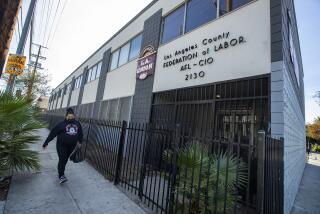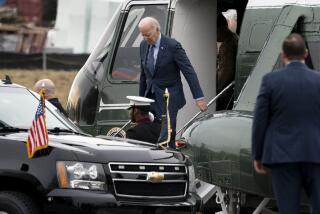Questions Surround Clinton’s Grand Jury Video Testimony
- Share via
WASHINGTON — Of all the issues that now loom over a beleaguered White House, the question of camera angles might not be the first that comes to mind.
But when President Clinton gazes into a video camera inside the White House next Monday and testifies, as planned, to a grand jury in a courthouse several blocks away, the questions of who controls the camera, how it is aimed and the visual image the president leaves behind could have consequences that linger long after independent counsel Kenneth W. Starr moves on to other pursuits.
“If I were Clinton, I wouldn’t be thinking so much about the grand jury,” said Leonard L. Cavise, a professor at DePaul University College of Law, and an expert in evidence and criminal law. “I’d be thinking about the use of this tape when it’s picked up by the media.”
Public curiosity may focus on the titillating details of what the president may reveal about his relationship with Monica S. Lewinsky, the former White House intern who reportedly has testified that the two had an affair. But Clinton and his handlers must consider an array of related concerns that arise from the remarkable spectacle of a president being interrogated on camera about details he surely thought would never become embroiled in a national brouhaha.
From high-tech privacy to low-tech politics, Clinton’s video testimony raises novel issues. There is the basic matter of preventing electronic eavesdropping, a presumed concern of all the parties and one that will require the use of sophisticated encryption technology. There is the political consideration that, under certain circumstances, tape of Clinton’s testimony could end up in Republican attack ads or television news shows.
On top of all that, legal experts pointed out, the video is potentially a graphic piece of evidence that could be used in future court or congressional proceedings, a visual record carrying far more wallop than words on a printed page. Lawyers and scholars alike question the effect of subtle visual signals on weighty matters of justice.
For instance: “You wonder, will the president show up in full make-up or not--and what impact that has,” said Bert Deixler, an attorney in Los Angeles.
“From what we can tell, seeing and hearing the person [on video] has a much greater impact than just having someone describe or relate what a person said,” noted Fredric I. Lederer, a professor at William & Mary School of Law and authority on technology in the courtroom. But, of proliferating video cameras in court proceedings, he added: “It’s amazing how little we know about how people react to all this.”
Few doubt that the presidential videotape could bristle with political significance.
Precedent was set two years ago, when defense attorneys sought Clinton’s testimony for a Whitewater-related trial in Little Rock, Ark. In the White House Map Room, the president answered questions from defense and prosecution lawyers for about three hours, while the judge presided from the court in Arkansas, linked to the White House by satellite. Jurors later watched the testimony on videotape.
The prospect of both the video and the live feed caused jitters for the White House before that 1996 testimony.
Floyd Brown, a conservative activist--he created the infamous “Willie Horton” ad that pounded Democratic presidential candidate Michael S. Dukakis for releasing a convicted murderer as governor of Massachusetts--sought that videotape in court. Clinton’s lawyers warned of “out-of-context replays and similar misuse, as well as commercial and political exploitation.”
U.S. District Judge George Howard Jr. was persuaded. He locked up the videotape, although he released a printed transcript. (Clinton testified on one other occasion by videotape in 1996, and that video also remains sealed.)
“There was tremendous concern, partially because this was in the midst of the political campaign, that someone would gain access to the testimony,” recalled Mark D. Fabiani, a former White House attorney who is now a crisis management consultant in La Jolla.
Brown would like to get his hands on Clinton’s upcoming videotape, though he has been advised that rules of grand jury secrecy may keep it out of reach. If circumstances change, however, Brown vows to go after it. “At that time we would move aggressively to have that testimony see the light of day,” he said in an interview from his Seattle office.
In the spring of 1996, White House officials also fretted over rumors that the president’s enemies would intercept the transmission of his testimony by manipulating a satellite dish. To prevent that, White House communications personnel in Washington and Little Rock made sure that the satellite transmission remained scrambled and off limits.
According to experts on video-image security, the president’s upcoming testimony likely will be conveyed to the U.S. District Court in Washington with digital transmission technology, more modern than the “analog” used for commercial television shows. Using the newer technology, his words and image would move as light waves streaming through fiber-optic lines. The process would create a huge challenge for any aspiring “fiber-tapper,” because the resulting loss of light could set off alarms at the signal’s receiving end in the court building.
But however his testimony is transmitted--whether in the form of radio waves used with a satellite, fiber-optic cables, older telephone lines or even coaxial cables buried underground--scrambling methods almost certainly will be used to foil any eavesdropper.
“For under $20,000 you could set up the computers on both ends . . . “ said Clifford Neuman, a computer scientist at USC. “It’s certainly unlikely that anyone would be able to break the security of the signal.”
In theory at least, Clinton’s testimony could leak out in other ways. “If I were going to try to eavesdrop on this testimony, I’d sit outside the White House with a boom mike and see if I could pick it up,” said a private sector security specialist who declined to be identified. “Of course,” he hastened to add, “I wouldn’t do anything like that.”
Certainly, a list of potential leakers would have to include legal personnel and the grand jury. Declared Bruce Schneier, a cryptography consultant in Minneapolis: “Technology makes any technological attack infeasible. What it does not do is secure the people. I’d want to make sure that everyone in the room listening to the testimony doesn’t have a recording device.”
Remote testimony to a grand jury, such as Clinton is scheduled to provide, is extremely unusual if not unprecedented, experts said. By contrast, the use of video has become increasingly common in other court proceedings.
Video technology has its limits, experts pointed out: Depending on the use of cameras, video imagery may omit telling details that jurors would observe if everybody were in the same room. Is a witness sweating? Does he or she have an off-camera coach? Are his hands fidgeting nervously?
Because grand juries invariably follow a prosecutor’s lead, unlike their trial counterparts, the Clinton videotape may have its greatest impact in other settings in the future, such as the court of public opinion.
But the video testimony could affect important, near-term calculations: If Clinton opts to discuss his testimony publicly, some believe it would undermine legal arguments that the videotape should remain confidential.
“To the extent that the president decides to tell the American people what he said before the grand jury, there would be a strong argument that the videotape of his testimony should be made public,” maintained Theodore J. Boutrous Jr., a Washington attorney who has followed 1st Amendment issues in Starr’s investigation for media clients, including The Times.
More to Read
Get the L.A. Times Politics newsletter
Deeply reported insights into legislation, politics and policy from Sacramento, Washington and beyond. In your inbox twice per week.
You may occasionally receive promotional content from the Los Angeles Times.










